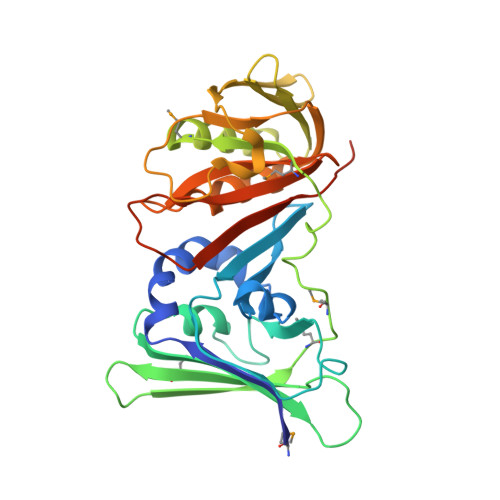Crystal structure of Epstein-Barr virus DNA polymerase processivity factor BMRF1
Murayama, K., Nakayama, S., Kato-Murayama, M., Akasaka, R., Ohbayashi, N., Kamewari-Hayami, Y., Terada, T., Shirouzu, M., Tsurumi, T., Yokoyama, S.(2009) J Biol Chem 284: 35896-35905
- PubMed: 19801550
- DOI: https://doi.org/10.1074/jbc.M109.051581
- Primary Citation of Related Structures:
2Z0L - PubMed Abstract:
The DNA polymerase processivity factor of the Epstein-Barr virus, BMRF1, associates with the polymerase catalytic subunit, BALF5, to enhance the polymerase processivity and exonuclease activities of the holoenzyme. In this study, the crystal structure of C-terminally truncated BMRF1 (BMRF1-DeltaC) was solved in an oligomeric state. The molecular structure of BMRF1-DeltaC shares structural similarity with other processivity factors, such as herpes simplex virus UL42, cytomegalovirus UL44, and human proliferating cell nuclear antigen. However, the oligomerization architectures of these proteins range from a monomer to a trimer. PAGE and mutational analyses indicated that BMRF1-DeltaC, like UL44, forms a C-shaped head-to-head dimer. DNA binding assays suggested that basic amino acid residues on the concave surface of the C-shaped dimer play an important role in interactions with DNA. The C95E mutant, which disrupts dimer formation, lacked DNA binding activity, indicating that dimer formation is required for DNA binding. These characteristics are similar to those of another dimeric viral processivity factor, UL44. Although the R87E and H141F mutants of BMRF1-DeltaC exhibited dramatically reduced polymerase processivity, they were still able to bind DNA and to dimerize. These amino acid residues are located near the dimer interface, suggesting that BMRF1-DeltaC associates with the catalytic subunit BALF5 around the dimer interface. Consequently, the monomeric form of BMRF1-DeltaC probably binds to BALF5, because the steric consequences would prevent the maintenance of the dimeric form. A distinctive feature of BMRF1-DeltaC is that the dimeric and monomeric forms might be utilized for the DNA binding and replication processes, respectively.
Organizational Affiliation:
Division of Biomedical Measurements and Diagnostics, Graduate School of Biomedical Engineering, Tohoku University, Sendai 980-8575.
















